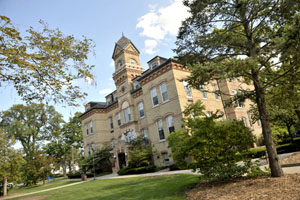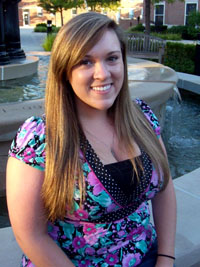Race Out Loud: Cherokee values at Elmhurst College
By Alison Cuddy

Race Out Loud: Cherokee values at Elmhurst College
By Alison Cuddy
Elmhurst College is pretty much postcard perfect—just how you’d imagine a liberal arts school would look. At the center of campus is a small mall, bordered by a trim row of student housing. On the late summer day I visited, everything was lush and green. And quiet - students were still on summer break.
From many points on campus you can see the spire of Hammerschmidt Chapel, a towering reminder of Elmhurst’s religious roots. Inside the lobby of Lehmann Hall is a tile mosaic inscribed with the Elmhurst motto: “An ever widening circle.” It was adopted in the 1920s by an Elmhurst president. But the mosaic also reflects the man currently in charge, S. Alan Ray.

“The Cherokee motifs are in the corners, the triangles you see in the corners,” says Ray. “This is typical Cherokee scroll work that you would see…oh, in any number of fabrics or bolo neck ties.”
Ray became the 13th president of Elmhurst College in 2008. He’s a native of Oklahoma and a product of some of the most prestigious institutions of learning in the United States, including Harvard Law School. But he was born to a young woman from a very different world.
“Her family I’ve since come to learn a bit about was a traditional Cherokee home, Cherokee was spoken. And I’ve often thought how my life would be different if I had grown up in that circumstance rather than the one that I did.”
Ray’s birth mother, a member of the Cherokee Nation, gave him up for adoption when he was an infant. From what he’s learned she was very young and unmarried. It was the mid-1950s and so, like many Indian children at the time, Ray was adopted by a white couple. Their names: Stephen and Dorothea Ray.
A visibly emotional Ray told me, “My mother is one of my heroes in life.” His father died when he was 5, and Dorothea Ray had to go back to school, find work. But Ray is most proud of the stand she took in their small town of Guthrie, Oklahoma.

Ray says “It was essentially segregated. The African Americans went to one school on one side of the town, where they lived. And white students went to another. My mother volunteered to teach the students in the African-American school. And she more importantly befriended her students and brought them to our house for a party, or several parties.Which was just unheard of and I think remarked upon in the neighborhood, that this was something crossing a color line. But that struck me, because she was a woman of great principle, and she interpreted her gestures not as some civil rights gesture, but as basic fairness and care and compassion for persons under her charge.”
Dorothea Ray also transformed Ray’s life. Early on she told him he was adopted and of Cherokee descent. And she managed to open his adoption records – no easy feat back then - so he could legally claim his heritage. What she couldn’t do was prepare Ray for the way others would view him.
“I remember in one case, I think I was in 7th grade, I was with some of my closest friends,” says Ray. “And I shared with them that I was adopted and I was Cherokee. And I had not done that previously and it was not a big deal to me, I just wanted to share this with them because I thought it was interesting. And I began to be called a redskin, you know I was an Indian. It was deeply pejorative and that surprised me.”
Ray is light skinned and blue eyed. Many would not recognize him as Cherokee. He says, sometimes when people learned of his background their perception of him changed.

“These negative characteristics of idleness, alcoholism, dysfunction, dark skin, various physical features are negatively valued and once one identifies as Native American, those are ascribed to them as they were to me, even those it was physically impossible to recognize me as that, in all respects.”
The prejudice didn’t make Ray reject his identity. But he wasn’t up for the role of model minority either. Instead, he says “What I did think was that I’m going to teach you what it is to be this Native American. And what it is to be this Native American, for me, is to be a Cherokee.”
From the start, Ray made his Cherokee heritage a part of his role at Elmhurst. At his inauguration, there was Native American music, drumming, and smudging, a purification ritual. Ray invited other Indian leaders, including the Reverend Rosemary McCombs-Maxey – the first female Native American ordained by the United Church of Christ. McCombs is from the Creek Nation, historic rivals of the Cherokee. So some teasing was in order. In her remarks McCombs-Maxey quipped, “I am showing you my credentials, hoping that my 11/16ths degree trumps your Cherokee blood quantum.”

Each spring break nursing students can volunteer for service in the Cherokee nation. Last March Patsis worked with members of the Snowbird community in Tennessee. It was Patsis’ first time around Cherokee. “I come from a really small not diverse community I think we’re ninety-eight percent Caucasian,” says Patsis. “So for me you get a little resistant when you get into new cultures and things when you come from something that’s so closed. But it just taught me to be so much more open and much less nervous to work with different communities and different types of people.”

Ray says ga-du-gi is becoming more familiar around campus. But it takes constant effort. “It’s something I have to reintroduce all the time because our students come and go,” says Ray. “And it’s also important that it not be something that’s just sort of ‘oh that’s Alan’s thing.’ But to try and continually interpret that as another way of understanding what our mission here is.”
In a way what Ray is doing at Elmhurst College is what he did with his Cherokee heritage: join the team - or tribe, or institution. Then slowly, over time, define the experience on your own terms. And then pass it on.





